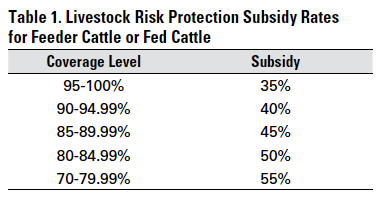Bagley Risk Management : Safeguarding Your Business Future
Bagley Risk Management : Safeguarding Your Business Future
Blog Article
Understanding Animals Threat Security (LRP) Insurance Coverage: A Comprehensive Guide
Navigating the world of animals threat security (LRP) insurance policy can be a complex venture for lots of in the farming field. From how LRP insurance policy operates to the numerous coverage alternatives available, there is much to discover in this thorough overview that might possibly shape the method livestock producers approach risk management in their companies.

Just How LRP Insurance Policy Functions
Sometimes, recognizing the mechanics of Livestock Risk Protection (LRP) insurance can be complex, however damaging down exactly how it works can give quality for ranchers and farmers. LRP insurance is a risk management device designed to protect animals manufacturers versus unanticipated rate decreases. It's crucial to keep in mind that LRP insurance policy is not a revenue guarantee; instead, it concentrates exclusively on cost danger protection.
Eligibility and Coverage Options

When it comes to coverage choices, LRP insurance policy provides manufacturers the flexibility to pick the coverage degree, coverage period, and recommendations that finest match their risk monitoring requirements. Protection degrees commonly range from 70% to 100% of the anticipated finishing value of the insured animals. Producers can additionally select coverage durations that align with their production cycle, whether they are insuring feeder cattle, fed cattle, swine, or lamb. Endorsements such as cost danger security can additionally tailor insurance coverage to secure against unfavorable market changes. By recognizing the qualification standards and insurance coverage choices available, livestock manufacturers can make enlightened choices to take care of threat effectively.
Advantages And Disadvantages of LRP Insurance
When reviewing Animals Danger Security (LRP) insurance coverage, it is crucial for animals manufacturers to evaluate the advantages and disadvantages integral in this danger management device.

One of the primary advantages of LRP insurance policy is its ability to supply security against a decline in animals prices. This can assist secure manufacturers from financial losses arising from market variations. In addition, LRP insurance coverage provides a degree of flexibility, enabling producers to customize coverage degrees and plan durations to match their specific needs. By securing a guaranteed rate for their animals, producers can much better manage danger and strategy for the future.
One constraint of LRP insurance is that it does not shield against all types of dangers, such as disease outbreaks or natural calamities. It is vital for manufacturers to thoroughly analyze their private risk exposure and financial circumstance to figure out if LRP insurance policy is the appropriate risk management tool for their operation.
Understanding LRP Insurance Policy Premiums

Tips for Taking Full Advantage Of LRP Benefits
Taking full advantage of the advantages of Livestock Risk Defense (LRP) insurance needs strategic planning and aggressive threat administration - Bagley Risk Management. To maximize your LRP protection, take into index consideration the adhering to tips:
Regularly Evaluate Market Conditions: Keep educated concerning market fads and rate variations in the animals industry. By keeping an eye on these aspects, you can make enlightened decisions about when to buy LRP coverage to secure versus prospective losses.
Establish Realistic Protection Levels: When picking insurance coverage degrees, consider your production expenses, market price of animals, and possible risks - Bagley Risk Management. Establishing reasonable protection levels ensures that you are appropriately shielded without paying too much for unnecessary insurance coverage
Diversify Your Coverage: Instead of counting exclusively on LRP insurance coverage, think about diversifying your threat monitoring approaches. Incorporating LRP with various other risk management tools such as futures contracts or options can provide extensive protection versus market uncertainties.
Evaluation and Adjust Insurance Coverage Frequently: As market conditions alter, regularly review your LRP protection to guarantee it aligns with your existing threat direct exposure. Readjusting coverage degrees and timing of acquisitions can help optimize your risk security strategy. By adhering to these ideas, you can take full advantage of the benefits of LRP insurance policy and secure your livestock procedure against unforeseen risks.
Verdict
To conclude, livestock risk protection (LRP) insurance coverage is a beneficial tool for official website farmers to take care of the economic threats connected with their animals operations. By recognizing how LRP functions, qualification and coverage alternatives, as well as the benefits and drawbacks of this insurance, farmers can make educated decisions to shield their incomes. By carefully considering LRP premiums and executing methods to optimize advantages, farmers can minimize potential losses and ensure the sustainability of their operations.
Livestock producers interested in obtaining Livestock Risk Security (LRP) insurance coverage can check out a variety of qualification requirements and insurance coverage options tailored to their particular livestock procedures.When it comes to coverage options, LRP insurance policy offers producers the versatility to choose the insurance coverage level, insurance coverage duration, and endorsements that finest match their threat administration requirements.To understand the details of Animals Danger Security (LRP) insurance coverage fully, recognizing the variables affecting LRP insurance coverage premiums is important. LRP insurance coverage premiums are established by numerous components, consisting of the protection level chosen, the expected price of livestock at the end of the coverage period, the more info here type of animals being insured, and the size of the insurance coverage period.Review and Change Insurance Coverage Routinely: As market conditions change, occasionally examine your LRP coverage to guarantee it straightens with your current risk exposure.
Report this page